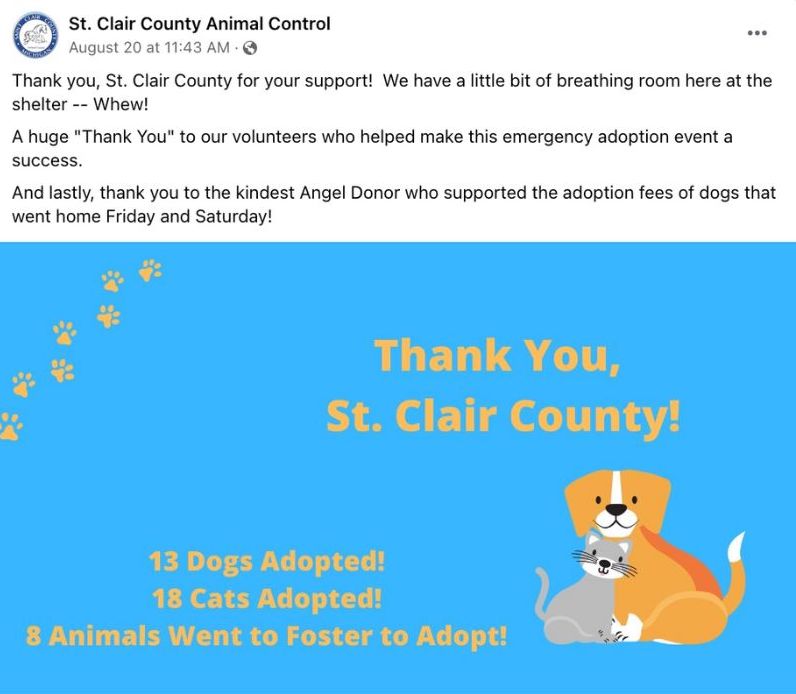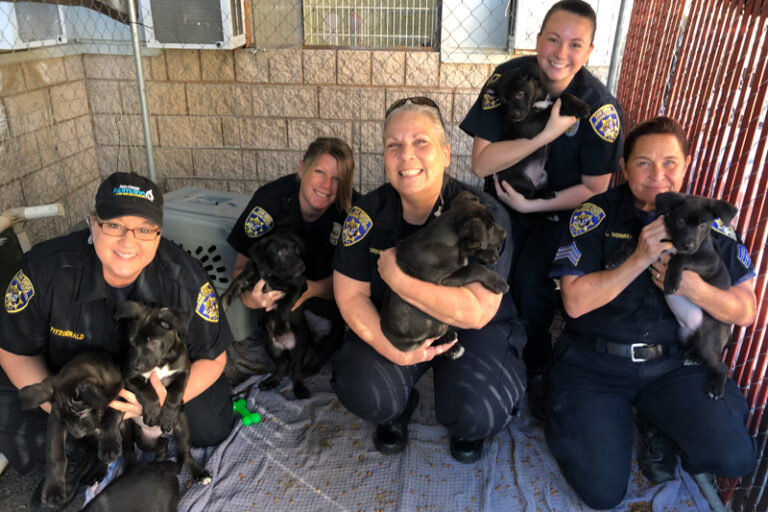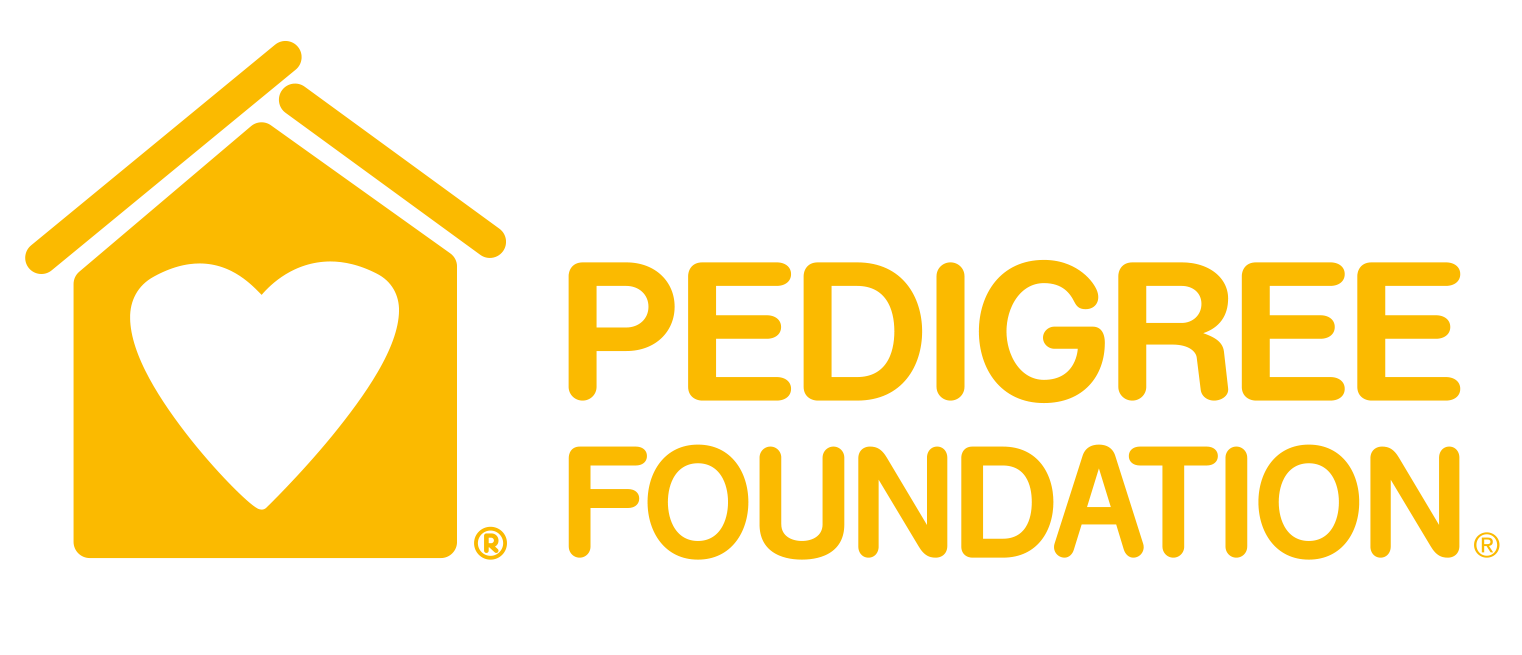In this hard summer, of a hard year, we wanted to know what was giving people in animal welfare hope, and strength. What is keeping you going, keeping you fighting for the animals in your care, and the families in your community?
Below, we’ve shared some of what you told us. It’s very moving, and powerful, and inspiring. We teared up more than once, to be perfectly frank, hearing what you had to say.
Thank you to everyone who spoke with us. And thank you to all of you who are working so hard, through all of this, to keep pets safe and people and pets together. Thank you for what you do.
“My colleague and I run our pet food pantry and the days we distribute food are the best days of the month. It’s like Christmas,” says Sandra Smith, who is director of community programs at Humane Animal Rescue of Pittsburgh. Sandra tells us this year, HARP has given out about 45,000 pounds of food and helped support nearly 3,000 pets and their families. “It’s been a seriously rough summer,” she says, “but being able to do this has been a saving grace.”
Wink lost his family this summer, “due to landlord issues,” Susan Naylor, associate director at SPCA of Brevard in Florida, wrote on Facebook.
Wink’s owner loved him very much. She was devastated to lose him, and he was devastated to lose her, too. In the shelter, Wink tried to hide by pressing himself against a wall, and growled at everyone he encountered.
Susan and the other staff at SPCA of Brevard were determined to help Wink feel safe in this new environment. They showed him kindness, and fed him cheese. And a week after his arrival, while Susan was on a Zoom call, Wink “decided to blossom,” as Susan puts it. “I almost cried watching him. This is why I love my job. Lots of days are rough, but remembering the days when a terrified dog finally decides to trust me makes everything else worth it.”
Susan tells us that Wink has now become a “helper dog” to another scared pup. Her name is Ruth. She just arrived at Brevard after four years in another shelter. “She’s super shy and shut down, but she will at least go outside if he goes with her,” Susan says. Hey Floridians—they’re available to go into foster!
At the beginning of April, a dog came into KC Pet Project in Kansas City, Missouri, who wasn’t using her back limbs. It was thought she’d been hit by a car. But then KC Pet Project staff “discovered her problems were more in-depth,” says Liz Meyer, the organization’s surgery technician lead. The dog’s hip was fractured, she had a serious heart murmur, and “the doctors could not believe the size of her heart!”
Meanwhile, more and more pets were coming in needing medical care, and “our hospital areas became very cramped,” Liz says. So she decided to take the dog, Polly, home as a “fospice”—to give her a comfortable place to stay, for what might not be a long life.
Some five months later, Polly is not just still alive, but “has flourished. The once shy, nervous dog has a house full of dog friends who she romps with daily,” Liz says. “She is no longer on pain medications, regaining muscle in the atrophied leg, and giving all of my dogs a run for their money.” Polly is doing so well that she may even be able to go up for adoption.
“This was one of those minor moves, that became a major change. Everyone in our clinic is rooting for her,” says Liz.
Stephanie Harris, co-founder of Family Forever Animal Foundation in Apopka, Florida, says her organization has “really shifted focus from rescuing/adoptions to fundraising to support people in getting vet care to prevent surrenders and unnecessary euthanasia.”
The other day, FFAF bought insulin for a newly diagnosed diabetic kitty, whose owner thought until then that euthanasia would be the only option. “Another story is that we have a blind dog who has an infected molar and needs to see a specialist,” Stephanie says. “Our amazing supporters donated upwards of $800 in, like, three days so we can get him his surgery. Our mission is to keep animals happy, healthy, and at home with the people who love them. And it fills my cup every day.”
Olivia Clark, who has worked as an adoptions counselor for BARCS in Baltimore for two years, tells us “one thing that has kept me going is seeing the pure joy and happiness on adopters’ faces when you connect them with their new family member. You can really tell when you’ve made someone’s day and completed a family.”
Olivia tries to make connections with all of her adopters, and a few “have blossomed into friendships over the years. Getting those frequent and intimate updates on how their new babies are doing makes me extremely happy. It reminds me that even on the hard days I am making a difference in someone’s life—and giving that same joy to an animal.”
Fredrica Lewis has worked at LifeLine Animal Project in Georgia for 10 years, and she’s worked in animal welfare for 15. Now an animal care manager; in this decade and a half, Fredrica has held nearly every job there is to do at a shelter.
“Animal Care Specialist (Kennel Tech, Different Locations), Lead Veterinary Assistant, Clinic Manager (Different locations), Animal Care Supervisor, and Animal Care Manager (Different locations). So I have seen and experienced a lot over the years,” Fredrica said in an email. “What brings the most joy to me is caring for the animals in our possession and working with the ones who care for them.”
Fredrica came into this field without experience. When she got her first job at Fulton County Animal Services, her coworkers “welcomed me with open arms.” That’s the model she’s followed since.
“My manager, supervisor, and the veterinarian at the time saw my potential and poured their knowledge into me, so I make a point to do the same for those starting after me,” Fredrica says. “It’s not roses but as long as I know everyone is putting in a real effort I can keep going. Workplace morale is extremely important in our field, along with compassion for people and animals. During these times we have to be there for each other and the animals the best we can.”
Cody Trespalacios, volunteer coordinator for Charlotte-Mecklenburg Police Department Animal Care & Control in Charlotte, North Carolina, says there are two main things that help keep him going.
“The biggest one, and maybe it’s overused and a bit cheesy, would be the animals themselves. There are specific ones that I get attached to of course, but I mean in general,” he says. “Right now we have probably over 150 dogs and many of them are long term but if you walk by their kennels you get the most sincere reaction of admiration and hope every time.”
Cody says that going out into the community, and talking to people about the current state of sheltering, also helps him persevere—because each of these conversations, can lead to more people being part of the work to protect animals and preserve families; toward better summers, in better years.
“I always end up having a conversation with someone who doesn’t really understand the current situations with shelters,” Cody says. “And it makes me feel better about the future knowing that I get the opportunity to plant these seeds into neighborhoods about the good, if not tough, work that we are doing and the help that we need.”
Memphis Animal Services has been full all summer. Then a couple of weeks ago, things got especially rough. “We’ve been doing everything we can to avoid euthanizing healthy friendly dogs for space, and it felt like we were out of options,” MAS’s director Alexis Pugh wrote on Facebook:
“Every single kennel was full, and when I say every kennel, I mean every physical kennel, rolling kennel, office; there was nothing left. Officers were standing by with dogs waiting for other dogs to be discharged and their kennel cleaned so they had somewhere to go. We were so short-staffed and so overwhelmed with animals, it felt pretty hopeless. We needed a miracle.
And guess what- once again, the universe listened. The miracle happened. Memphis, this amazing city I get to call my home, stepped up.
Between Friday, Saturday and Sunday, 147 animals get either adopted rescued or returned to home and 55 animals went to foster. That’s right- 202 dogs and cats left the building. Even our longest term foster Allan got adopted on his one-year anniversary in foster!!!
This gave us a brief respite from the overwhelm of the past months. We were able to spend some time getting dogs out for some sunshine and play time in the yard, something we haven’t even been able to do recently. At the time of publishing this post (Wednesday 8/17), we are already full again. But it’s worth celebrating the fact that, when a community comes together to save lives, it works.
So thank you. Thank you for reminding us that together, with positivity and collaboration, the impossible can become reality.”
Jeanette Garlow, co-director of Lost Dogs Illinois—an organization that helps reunite lost dogs with their families—reached out by email to say how this group’s mission takes on extra importance and urgency while so many shelters are full.
“We are able to help good Samaritans and police departments get animals home before they get to shelters, along with assisting in getting them out of the shelters quicker to make room for animals that truly need to be there,” Jeanette says—proudly pointing to success stories on the LDI website.

“Our Community Pet Clinic Days are what keep me going,” says Shannon Glenn, executive director of My Pit Bull is Family, which has as one of its projects the North Minneapolis Pet Resource Center. “We’re able to bring the community together to support people and pets.”
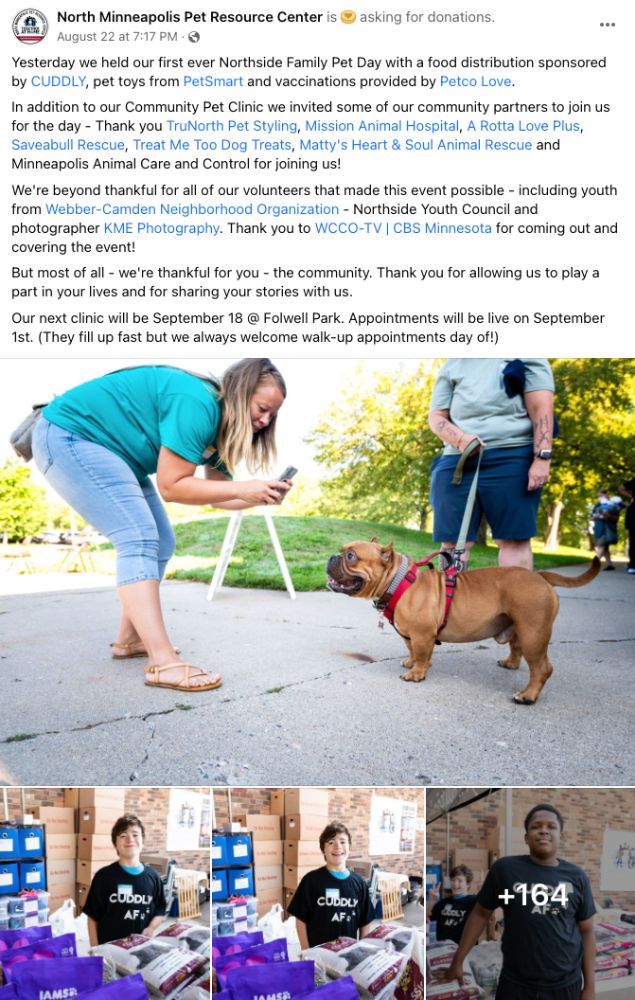
“To be honest, our pet food pantry keeps me going most days,” says Mindi Callison, founder and executive director of Bailing Out Benji—a nonprofit whose primary mission is raising awareness about puppy mills. (You may have heard Mindi on Sony’s recent investigative podcast Puppy Kingpin!)
Bailing Out Benji also founded a pet food pantry in Ames, Iowa, five years ago. “Each month we provide pet food and supplies to hundreds of animals and we’ve been credited by our local shelter for keeping their intake numbers low,” says Mindi.
“I’m so happy that we have a program focused on keeping pets and families together. I truly believe that is the future of animal rescue: pivoting to fill these community needs in order to keep pets in their homes instead of the traditional rehoming practice.”
Melissa Miller, director of St. Clair County Animal Control in Michigan, only had a minute to speak when we called, because the shelter was running an emergency adoption event.
“The only kennels we have open are our holding kennel for our overnight strays,” Melissa said. “Trying to move animals out of here.”
The phones were ringing off the hook, with members of the community interested in the dogs and cats—which was very promising. And even besides that, Melisssa said, what was giving her hope and strength this summer, “it’s been my team. We’ve all done a really good job of supporting each other.”
“I think we’ve all had moments where it’s been overwhelming,” she said. “It’s been a really good team where we’ve been able to communicate and say, ‘Hey, I’m overwhelmed. Can you help me with this right now?'”
And with that, Melissa had to go. The adoption event, by the way, was a success.
